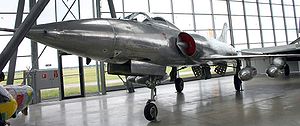- HAL HF-24 Marut
-
HF-24 Marut HF-24 Marut preserved at the Oberschleissheim museum near Munich Role Fighter-bomber Manufacturer Hindustan Aeronautics Designer Kurt Tank First flight 17 June 1961 Retired 1985 Primary user Indian Air Force Number built 147 [1] The Hindustan Aeronautics HF-24 Marut (Sanskrit: "Spirit of the Tempest") was an Indian fighter-bomber aircraft of the 1960s. It was India's first jet aircraft, first flying on 17 June 1961. The wooden mock-up of the aircraft was flyable as an air-launched glider.
Contents
History
The Marut was designed by the famed German designer Kurt Tank, but never realised its full potential due to insufficient power. The basic design was developed by Kurt Tank's team during Tank's days developing jet aircraft in Argentina, which was to be called Pulqui III, as a follow on for the Pulqui II. Tank departed Argentina for India carrying the Marut's concept with him. Although originally conceived to operate in the vicinity of Mach 2, the aircraft in fact turned out to be barely capable of reaching Mach 1,[2] due to the lack of suitably powered engines for the airframe. After the Indian Government conducted its first nuclear tests at Pokhran, international pressure prevented the import of better engines, or at times, even spares for the Orpheus engines. This would be one of the main reasons for this aircraft's early demise.
It was used in combat in the ground attack role, where its safety features such as manual controls whenever the hydraulic systems failed and twin engines increased survivability.
A total of 147 aircraft were built, including 18 two-seat trainers. The last examples were withdrawn from service in 1990.
Given the limited number of Marut units, most Marut squadrons were considerably over-strength for the duration of their lives. According to Brian de Magray, at peak strength No.10 Squadron had on charge 32 Maruts, although the squadron probably did not hold a unit-establishment of more than 16. All in all, the Marut squadrons acquitted themselves very well in the 1971 war. The Marut, as an aircraft, was shown to be tough and capable. No aircraft were ever lost in air-to-air combat. However, 4 were lost to ground fire and two were lost on the ground. The Maruts were in the thick of it, right through the fighting on the western front, and the Squadrons ended the war with a total of three Vir Chakras.[3]
A mock up of the Hf 24 Marut can be seen in Kamla Nehru Park in the city of Pune, India.
Operational history
In the 1971 war, some HF-24 Maruts and Hawker Hunter aircraft were used to assist the post at Battle of Longewala in the morning by the Indian Air Force. They were not outfitted with night vision equipment, and so were delayed from conducting combat missions until dawn.[4] In 1967, one Marut was used as a testbed for the Egyptian Brandner E-300 engine.[5]
Variants
- Marut Mk.1 : Single-seat ground-attack fighter.
- Marut Mk.1T : Two-seat training version.
Operators
- Indian Air Force
- No. 10 Squadron, Indian Air Force
- No. 31 Squadron, Indian Air Force
- No. 220 Squadron, Indian Air Force - last unit with the type, relinquished aircraft mid-1990[6]
Specifications (Marut Mk.1)
Data from Jane's All The World's Aircraft 1976-77 [7]
General characteristics
- Crew: 1
- Length: 15.87 m (52 ft 0¾ in)
- Wingspan: 9.00 m (29 ft 6¼ in)
- Height: 3.60 m (11 ft 9¾ in)
- Wing area: 28.0 m² (301 ft²)
- Empty weight: 6,195 kg (13,658 lb)
- Max takeoff weight: 10,908 kg (24,048 lb)
- Powerplant: 2 × Bristol Siddeley Orpheus Mk 703 After-burning turbojet, 32.4kN (6,275 lbf) dry, 47.2 kN (10,582 lbf) with reheat () each
Performance
- Maximum speed: 1,112 km/h (600 kn, 691 mph) at sea level
- Stall speed: 248 km/h (133 knots, 154 mph) (flaps and landing gear down)
- Combat radius: 396 km [1] (214 nmi, 246 mi)
- Service ceiling: 13,750 m[citation needed] (45,100 ft)
Armament
- Guns: 4× 30 mm (1.18 in) ADEN cannon
- Hardpoints: 4 with a capacity of 1,800 kg (4,000 lb) (total)
- Rockets: 50× 2.68 in (68 mm) rockets
See also
- Aircraft of comparable role, configuration and era
- Sukhoi Su-7
- Helwan HA-300
- Hawker Hunter, An aircraft with similar design.
- Related lists
- List of aircraft of the Indian Air Force
- List of fighter aircraft
References
- Notes
- ^ a b Donald 1997, p.523.
- ^ "HF-24 Marut". Federation of American Scientists. http://www.fas.org/man/dod-101/sys/ac/row/marut.htm.
- ^ http://www.globalsecurity.org/military/world/india/marut.htm
- ^ p.100, Nordeen
- ^ Taylor 1969, p.671.
- ^ Bharat-Rakshak.com, HINDUSTAN FIGHTER HF-24 MARUT, accessed July 2009
- ^ Taylor 1976, pp. 79—80.
- Bibliography
- Donald, David (editor). The Encyclopedia of World Aircraft. London:Aerospace, 1997. ISBN 1-85605-375-X.
- Taylor, John W. R. Jane's All The World's Aircraft 1969-70. London:Jane's Yearbooks, 1969.
- Taylor, John W.R. (editor). Jane's All The World's Aircraft 1976-77. London:Jane's Yearbooks, 1976, ISBN 0 354 00538 3.
External links
Hindustan Aeronautics Limited aircraft Manufacturer
designationsLight aircraft Trainers Fighters Helicopters Transports RTA • Saras
Gliders Ardhra • G-1
License built aircraft Aircraft designed by Kurt Tank Early years Rohrbach Ro VIII
For Focke-Wulf Fw 44 • Fw 56 • Ta 152 • Ta 154 • Ta 183 • Fw 187 • Fw 189 • Fw 190 • Fw 200 • Ta 254 • Ta 283 • Ta 400 • Project I • Project II • Project III • Project IV • Project V • Project VI • Project VII • Project VIII
Post-Second World War IAe Pulqui II • HAL HF-24 Marut
Lists relating to aviation General Aircraft (manufacturers) · Aircraft engines (manufacturers) · Airlines (defunct) · Airports · Civil authorities · Museums · Registration prefixes · Rotorcraft (manufacturers) · TimelineMilitary Accidents/incidents Records Categories:- HAL aircraft
- Indian fighter aircraft 1960–1969
Wikimedia Foundation. 2010.

